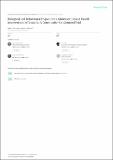| dc.contributor.author | Rossa, David A. | |
| dc.contributor.author | Changaluchab, John | |
| dc.contributor.author | Obasia, Angela I.N. | |
| dc.contributor.author | Todda, Jim | |
| dc.contributor.author | Plummera, Mary L. | |
| dc.contributor.author | Cleophas-Mazige, Bernadette | |
| dc.contributor.author | Anemonaa, Alessandra | |
| dc.contributor.author | Everetta, Dean | |
| dc.contributor.author | Weiss, Helen A. | |
| dc.contributor.author | Mabey, David C. | |
| dc.contributor.author | Grosskurth, Heiner | |
| dc.contributor.author | Hayes, Richard J. | |
| dc.date.accessioned | 2022-01-21T12:12:58Z | |
| dc.date.available | 2022-01-21T12:12:58Z | |
| dc.date.issued | 2007-02 | |
| dc.identifier.citation | Ross DA, Changalucha J, Obasi AI, Todd J, Plummer ML, Cleophas-Mazige B, Anemona A, Everett D, Weiss HA, Mabey DC, Grosskurth H, Hayes RJ. Biological and behavioural impact of an adolescent sexual health intervention in Tanzania: a community-randomized trial. AIDS. 2007 Sep 12;21(14):1943-55. doi: 10.1097/QAD.0b013e3282ed3cf5. PMID: 17721102. | en_US |
| dc.identifier.issn | 0269-9370 | |
| dc.identifier.other | PMID: 17721102 | |
| dc.identifier.other | DOI: 10.1097/QAD.0b013e3282ed3cf5 Full text linksCite | |
| dc.identifier.uri | https://repository.amref.ac.ke/handle/123456789/519 | |
| dc.description | A community-randomized trial. | en_US |
| dc.description.abstract | Objective: The impact of a multicomponent intervention programme on the sexual
health of adolescents was assessed in rural Tanzania.
Design: A community-randomized trial.
Methods: Twenty communities were randomly allocated to receive either a specially
designed programme of interventions (intervention group) or standard activities (comparison
group). The intervention had four components: community activities; teacherled,
peer-assisted sexual health education in years 5–7 of primary school; training and
supervision of health workers to provide ‘youth-friendly’ sexual health services; and
peer condom social marketing. Impacts on HIV incidence, herpes simplex virus 2
(HSV2) and other sexual health outcomes were evaluated over approximately 3 years in
9645 adolescents recruited in late 1998 before entering years 5, 6 or 7 of primary
school.
Results: The intervention had a significant impact on knowledge and reported attitudes,
reported sexually transmitted infection symptoms, and several behavioural outcomes.
Only five HIV seroconversions occurred in boys, whereas in girls the adjusted rate ratio
(intervention versus comparison) was 0.75 [95% confidence interval (CI) 0.34, 1.66].
Overall HSV2 prevalences at follow-up were 11.9% in male and 21.1% in female
participants, with adjusted prevalence ratios of 0.92 (CI 0.69, 1.22) and 1.05 (CI 0.83,
1.32), respectively. There was no consistent beneficial or adverse impact on other
biological outcomes. The beneficial impact on knowledge and reported attitudes was
confirmed by results of a school examination in a separate group of students in mid-
2002.
Conclusion: The intervention substantially improved knowledge, reported attitudes
and some reported sexual behaviours, especially in boys, but had no consistent impact
on biological outcomes within the 3-year trial period. | en_US |
| dc.description.sponsorship | European Commission, Development Cooperation Ireland (Irish Aid), UK Medical Research Council, UNAIDS, and UK Department for International Development | en_US |
| dc.language.iso | en | en_US |
| dc.publisher | Lippincott Williams & Wilkins | en_US |
| dc.subject | Adolescents | en_US |
| dc.subject | HIV | en_US |
| dc.subject | Pregnancy prevention | en_US |
| dc.subject | Sexually transmitted infections | en_US |
| dc.subject | Tanzania | en_US |
| dc.title | Biological and Behavioural Impact of an Adolescent Sexual Health Intervention in Tanzania: A Community-Randomized Trial | en_US |
| dc.type | Article, Journal | en_US |

